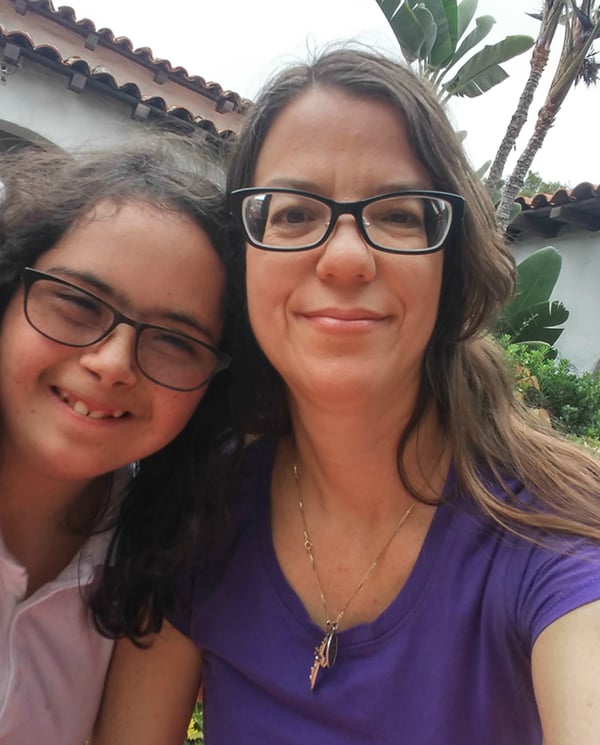I have four compassionate and tenderhearted children. But it was one in particular who took care of me after my eye surgery.
It wasn't the oldest and smartest one, the strongest one or the one who is the swiftest and most agile. The child who took care of me is none of these things. She is the one with Down syndrome.
While my oldest provided some routine, obligatory care early on and then returned to her friends on social media, my boys waged Nerf gun battles over my head, apparently unaware how unnerving it is to have flying projectiles -- even light-weight foam ones -- whiz past your swollen, red, seeping eye. But my 14-year-old Teresa was there for the long haul. She spent three days by my side, bringing me my water, Ibuprofen, eye ointment, blankets, phone and food, giving me hugs, praying for my recovery, asking me over and over again if my eye feels better and crying when I had to answer "not so much yet." She refused to leave my side even to go downstairs and eat her favorite Taco Bell nachos that my husband picked up. I shouldn't have been surprised. I knew this is the kind of person she is. But I was in awe at how precisely art imitates life.
[Tweet "Does art imitate life? Or does life imitate art? @Lily_Trilogy thinks it's both."]
In 2011, when Teresa was only nine years old, I published a series of novels, the first of which, Until Lily, is about how a woman with Down syndrome is the only one who visits and takes care of her elderly aunt Bev. The simple moments of unreserved love that Lily pours out on Bev spurs the elderly woman's regrets of her own life-long failings to love with that brand of wild abandon.
I delight in writing fiction, but sometimes it’s hard to convince people I really do make stuff up. If I wrote the things that really happen in my life, people probably wouldn’t believe it. But my fiction has a certain plausibility, I guess, because often readers assume that the people and events I write about in my novels come from my real life.
In the Lily series, I write in first person, from the perspective of six different characters, each affected in a different way by Lily. People often want to know which of these characters I am.
Am I the old lady in the nursing home, looking back with regrets over the love she failed to give? Am I that woman’s daughter, whose marriage has grown stagnant and bond with her children grown cold? Am I the granddaughter, who harbors a heart-wrenching secret that prohibits her gift of self to the man she loves? Am I the great niece, whose confusion about what love is, leads her on an odyssey to find life's true meaning? Am I the grandson’s wife, who questions the very value of devoted love since it has proven insufficient to cure her husband’s depression? Am I the great-great niece with Down syndrome who, brokenhearted that her cousin is getting married, runs away from the wedding, gets lost in the streets of Boston and comes face to face with the kindness of strangers as well as the harshness and sorrows of the “Valley of Tears” through which we all walk?
Though I speak for each of these characters, and have grown to know them so well that they have become a part of me, I am none of them. But, for a day or two, I got a glimpse into what it might be like to have your heart transformed by one of them. Teresa became my Lily, and I got to experience, in my own real life, the character I created in a fictional world. I have to say, I marveled at her.
There’s an age-old debate: Does art imitate life? Or does life imitate art? From what I've seen, it's both. And I must admit, I don't mind at all. When it comes to Lily, I am grateful to be living out life's imitation.
Copyright 2016 Sherry Boas
About the Author
Sherry Boas
Sherry Boas is author of the Lily Series, which has grown into a beloved collection of novels whose characters’ lives are unpredictably transformed by a woman with Down syndrome. The former newspaper reporter and special needs adoptive mother of four is also author of A Mother's Bouquet: Rosary Meditations for Moms, Billowtail, Victoria's Sparrows, Little Maximus Myers, Archangela's Horse, and Wing Tip. She runs Caritas Press from her home office in stolen moments between over-cooking the pasta and forgetting to dust the chandelier. Find her work at CaritasPress.org.



.png?width=1806&height=731&name=CatholicMom_hcfm_logo1_pos_871c_2728c%20(002).png)
Comments